by Marcela M. | Dec 2, 2013 | Children, homeschooling, Pies, Recipe Box, Recipes, Sweets, Vegan & Raw
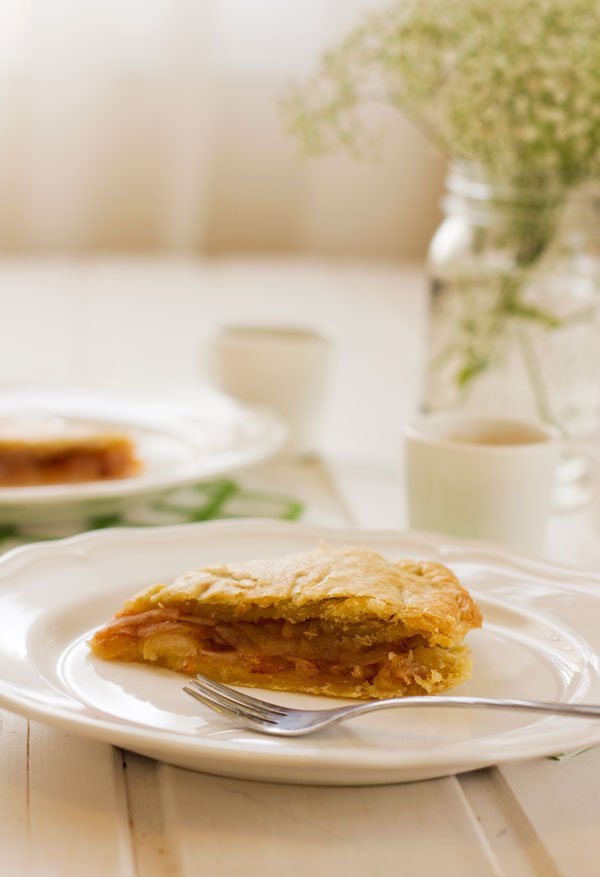
Good evening dear friends!
It’s been such a long, long time since I last visited this, my happy place, since I last talked to you, my dear friends. Summer came and went and so did most of Autumn (my favorite season!), and it is only now that the advent is almost upon us that our lives have regained some sort of normality, of calm and that I begin to find the way back to the words I have been wanting to write for a while.
So here I am, listening to The Piano, which is the soundtrack with which I have written every post of this blog, and thinking about the roller coaster of emotions that have been the last few months (pardon the cliché).
You see, On the 1st week of October: 1) We pulled Luka and Zoe out of their new school, worried about the high levels of stress that they were enduring and, advised by a psychologist, decided to home school them (insert worry, doubts and sadness), 2) We lost our babysitter ( a big deal for expats like us, trust me) and 3) I started working, from home, on the most amazing project I could have ever dreamed (insert jumps of joy and huge smiles). Our daily lives, and the plans we had for the immediate future, as you can imagine, changed pretty much overnight, and it has taken a while for all of us to re adjust and find the calm and quiet of a new normal.
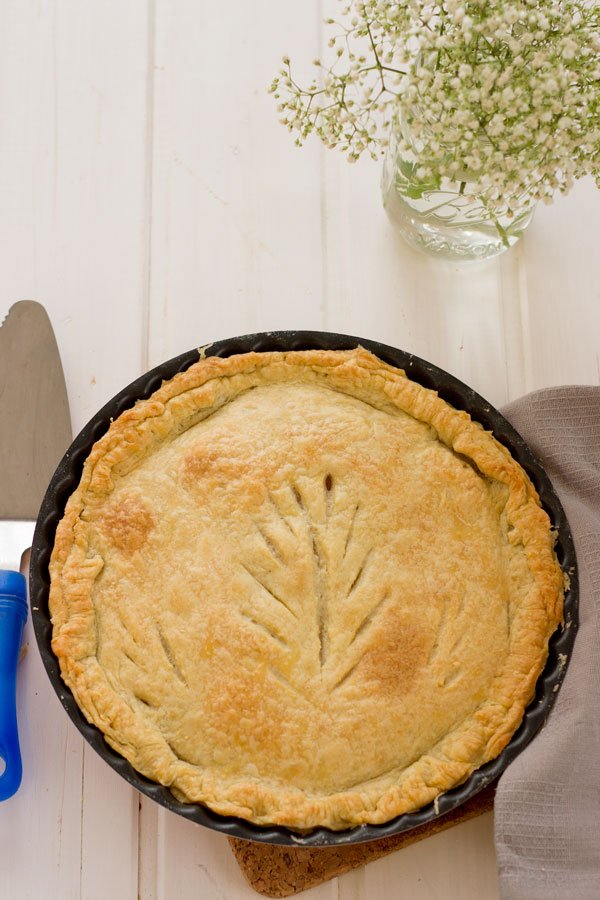
During all this time there were many occasions in which I sat at the computer with the intention to type a new blog post, only to be met by the most atrocious writer’s block. It seemed as though I had run out of words or, rather, as if I had too many words waiting to be said, too many raw emotions inside of me battling to be put on paper first. Should I talk to you about the sadness and worry for our children’s well being that had haunted us during September, or should I talk about the relief we found when, unexpectedly and surprisingly, we decided to home school them? And how to discuss the joy, hope and personal fulfillment that the new project I am working on had brought into my life? How could I piece those feelings together, in a blog post, or two, or three, when I was still dazed myself by all that had occurred?
I couldn’t.
And the more I thought about it, the more daunting the task seemed. As days and then weeks passed by, this first blog post acquired mythical proportions and it became more and more difficult to write.
Until this week, when I realized I didn’t have to do any of this: that I can take my time to write about it all in greater detail when the words come to me in their own time, and that I could just come back here being me, the confused, worried, joyful, warm and simply happy me that I have always been. And that I could just say hello to you again, bring you a piece of pie, and ask you (like old friends do):
How have you been, my dears, during all this time?
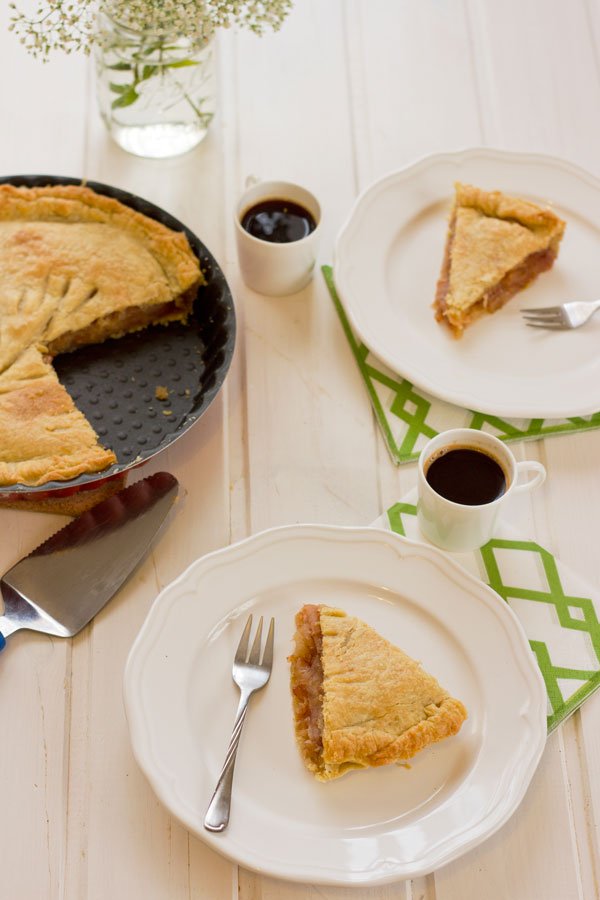
And speaking of pie, here’s the recipe I promised:
Vegan & refined sugar free apple pie
Ingredients: For the crust:400 grs all purpose flour, 200 grs margarine, cold (the best quality you can find, preferably from the health food store), 2 tablespoons coconut palm sugar, 1/4 cup very cold water. For the filling: 2 big Granny Smith apples, 3 tablespoons cornstarch, dissolved in cold water, 7 tablespoons coconut palm sugar, 2 tablespoons ground cinnamon.
Preparation:
1) Make the crust: Put flour, sugar and margarine in the food processor. Pulse until the flour reaches a sand-like consistency. Add water while the processor runs, until the dough separates from the bowl. Wrap the dough in foil and let it rest in the refrigerator for one hour. Note: If you don’t have a food processor, use two knives to incorporate flour, sugar and margarine.
2) After one hour, pre heat the oven to 180 C/ 350 F. Remove the dough from the refrigerator and divide it in two. Roll one half and cover the botton of a pie dish with it.
3) Prepare the filling: Peel and finely slice the apples and put them in the pie dish. Mix the dissolved cornstarch, coconut sugar and cinnamon and pour it evenly over the apples, to coat. Cover the dish with the other half of dough and bring it to the oven. Bake until the crust is golden. Serve warm and, if you are feeling decadent, accompanied by a scoop of good quality vanilla bean ice cream.
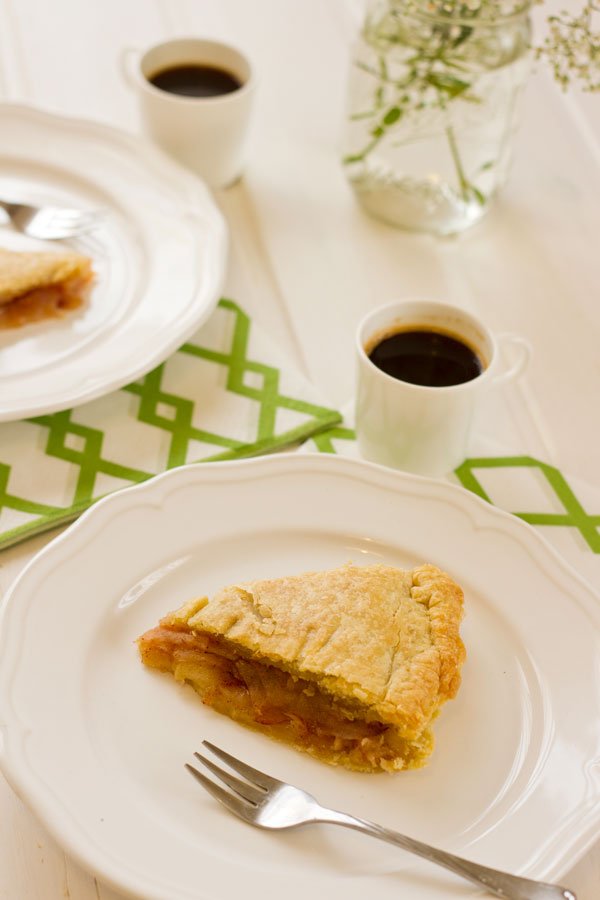
by Marcela M. | Jul 26, 2013 | Children, homeschooling

Spending Summer at home with kids means fun, water games and crazy schedules, right? Well, yes, but, let’s be honest, it frequently also means facing the inevitable “I AM BORED” (with tons of emphasis) and “I don’t know what to do!” and, in those cases, having a few summer themes and activities that are easy to put together in a whim and that will keep our children happy and stimulated becomes very (VERY) important.
So, if you are facing the prospect of a full month of August at home with your kids, and would like to be prepared, this post is for you! I have put together my tips for planning themes and gathering activities around them, so that you can plan the ones that are best for your child, and I have included a downloadable pdf with a list of great things to have at home to quickly put together fun projects and games. You can take this list with you when shopping for supplies and you can also use it as a checklist for things to recycle.
WHY PLAN ACTIVITIES AROUND THEMES
I know you may be wondering this. I also asked myself this question in the past and, after having tried this system, here are my reasons:
* Having a few themes makes it easier to find activities (I’ll show you how)
* It is easier to gather resources,which can then be reused several times within the same them
* Children get to explore a subject in greater depth, and when the subject is one they are already interested in, they get the most out of it.
Ready to get started? Here are my tips!
HOW TO PLAN FUN SUMMER THEMES AND ACTIVITIES FOR KIDS
1) Observe your child: What does your child like? What activities does he enjoy? What is he attracted to? What books does he prefer? Follow you child’s lead when choosing themes for greater success. For example, one of our themes this year is Space, because both Luka and Zoe are fascinated with stars, planets, galaxies, aliens and the solar system. As a consequence, every activity I suggest in this theme is quickly embraced and we have been able to do much more with it than if I had randomly chosen something else.
2) Think about some areas where your child may be struggling: Look at what your child is struggling with and use the opportunity to reinforce those areas through play and fun activities. Let him learn without realizing it. For example, if your child has an immature pencil grip or can’t use scissors properly, you could check this website for ideas on games that you can do with him in order for him to get better . If your child needs to work on controlling his temper, or getting better at socializing, you could check this website, makes face dolls with toilet paper rolls, use puppets to talk about feelings, etc.
3) Pick a few themes. After you have observed what your child likes and what he needs, decide on a few themes. I like to chose just a few, no more than 3 or 4, because I find that a bigger number can be overwhelming, especially when planning.
4) Create Pinterest boards: This is the fun part where we get to use pinterest for research 😉 I suggest opening a pinterest board for each theme, it will help you keep everything organized-remember that you then have to be able to use those ideas and in order to do that, you first need to find them.
5) Research: I use pinterest a lot for this purpose and I also visit my favorite children blogs. Here they are:
Modern Parents Messy Kids
Pink and Green mama
Mrs Ricefield
All the bloggers in this pinterest board
Remember to look for activities that are developmentally appropriate. If they are too easy, your child may get bored. If they are too difficult, he may become frustrated. Show him the next step, not the end of the ladder.
6) Start making lists of activities for each theme
7) Take a good look at your lists and ponder:Which ones are more complicated and require some preparation (example, planning an experiment, or building a rocket ship according to NASA’s instructions)?Which ones can be put together in no time and are sure to entertain bored little minds? Take a calendar and plan when to do the more complicated ones, but be realistic with your time and resources. I normally mix a more complicated one per day, or every two days, with simple ones (such as sensory work) and free time. You can decide to schedule themes per week or mix them all during the week, according to your child’s motivation and interests.
8) Write a bucket list. From each theme, select some to put into your list of things that you don’t want the Summer to end without having done. Themes aside, which other experiences do you wish to have this summer with your children. Make this a summer to remember!
9) Make a list of emergency activities Make a list of activities that are reaaaaaaaly easy to put together in a whim, for emergencies, and glue it to your fridge. I find that sensory work and water play work wonders in these cases.
10)Gather the materials: Now that you know what you want to do, look around your house: what do you already have that can be used?What do you need to buy? I find that a well stocked art basket/box is a precious tool because it allows us to always have the right resources on hand to bring all our projects to life. Luka and Zoe call it “the magic box” because we always find something fun to do with it. In order to help you put one together, I have attached below a pdf with my own list of resources. Use it to gather things around the house and to go shopping, if needed!
Last but not least, my dear friend Jo Ebisujima wrote a fabulous kindle ebook with +50 Montessori activities for kids aged 2-6 years old that was written by my dear friend Jo Ebisujima (she interviewed me last Sunday, by the way) and which is being offered FREE TODAY. So go grab your copy!

Now it’s your turn: do you plan your summer activities? which are your favorite ones? Let me know in the comments below!
by Marcela M. | Jul 8, 2013 | Children, homeschooling
Summer, summer, summer….what does it mean to you? Holidays? The Beach? Warm weather? Relaxation?
Chances are that, if you are a mum, Summer also means Kids at home 24/7 , and that your google searches from the end of May until the end of August are mostly focused on finding cool, entertaining, educational, fun and, yes, affordable, summer activities to do with kids.Am I right? Are you like me?
Then this blog post is for you!
As I mentioned before, Luka and Zoe are not going to Summer school this year, nor are we going on holidays because of my husband’s work, so this has meant finding TONS of activities to keep their energetic little minds and bodies active, stimulated and entertained. Summer in Cyprus is very, very hot, so it is not possible for us to spend all day outside and, since we live in an apartment, several activities have to adapted, but we make it work!
In following posts I will tell you all about how we are planning each day (schedules, schedules!) and I will share with you specific ideas, activities and resources for our “Summer themes” but, for today, here’s a list of general books I have found more useful in this process. With these resources on hand I know I’ll never run out of ideas for fun summer activities!
Here they are:
6 great resouces for fun Summer activities
1)The Pre-schoolers busy book: 365 creative games & activities to occupy 3-6 year olds: This is a wonderful general resource book that you can use all year long, for many years. What I love about this book is that it has resources for everything: rainy days, cooking with children, outdoor adventures, drama and music, arts and crafts, and even holiday activities. It also included lists of material to buy and recycle, lists of age-appropriate books and home-made recipes for things such as play-dough and bubble solution. If your child is smaller than 3 years, you may want to know that we had the previous one too (The Toddler’s busy book) and it is also great!
2) Camp mom: Summer activities pack: This is an ebook created by 20 blogger mums, full of guidance on how to plan, schedule and execute tons of super fun activities in three main themes: water, art and nature. Many of the ideas can be used all year long, and it also contains an area called “sensory play every day” which is great for emergencies (a.k.a I need an idea FAST!) and which includes links to sensory activities.
3) Self-Esteem games: 300 activities that make children feel good about themselves: I really love this book and it has been a wonderful resource for encouraging a sense of self in Luka and Zoe. The games help children focus on the things they do well, learn to love their names, getting to know themselves (their bodies, their feelings and emotions, their reactions) and learning how to be with others, how to trust and express affection. If you have a child who has been bullied or who has gone through a difficult first socialization experience, this is a beautiful book to add to your library.
4) Science is Simple: Over 250 activities for pre-schoolers: Children are naturally curious about the World around them and the early years are a great time to teach them to think scientifically: to question, to observe, to hypothesize, to draw conclusions. This book teaches children (and the adults teaching them) to be mindful about the world and think about things such as why do tree leaves change color, how to seeds grow, what is melting, what can the wind do, where do trees come from, how to explore the unknown and many, many others. What I love about this book is that it teaches children to find their own answers to the multiple whats, whys and hows they encounter everyday, and to be active in the finding of knowledge and not mere receptacles of the ideas of others.
5) Montessori Geography curriculum: This ebook was originally conceived to help Montessori teachers, but I have found wonderful ideas in it as well (and it’s free!). The main idea of the Montessori Geography curriculum is to help children develop spatial awareness and understand themselves as part of a bigger group that includes neighbourhood, city, country, continent and, ultimately, our planet. The instructions are detailed and the activities are, even though the country geography lessons are US-specific, they are easily adaptable.
6) Art not craft ebook: I love this ebook! I was not a creative person before having children and their artistic explorations opened a whole new world for me. This book provides instructions, ideas and resources for drawing, painting, printmaking, collage and even making sculptures, as well as ideas on how to prepare a creative space, how to store art materials and how to store artwork. (Note: the ebook I bought is no longer available for purchase and has been replaced by a book called “Time to create”, which is very similar)
In my next blog posts I will share with you our Summer themes (you may have guessed them from my book descriptions!) as well as the specific activities and resources that I have planned for each of them, so make sure to come back for more ideas. Or even better, subscribe to this blog in the pink box below to receive them all directly in your inbox!
Now it’s your turn: how are you planning your kid’s summer and what are your favourite resources for doing so? Let me know in the comments below!
NOTE: The links above ARE NOT affiliate ones. If you want to purchase these books using my affiliate link, you can go to The Celebration Girl’s amazon store
by Marcela M. | Jun 18, 2013 | Blog, Children, Europe, homeschooling, Travel
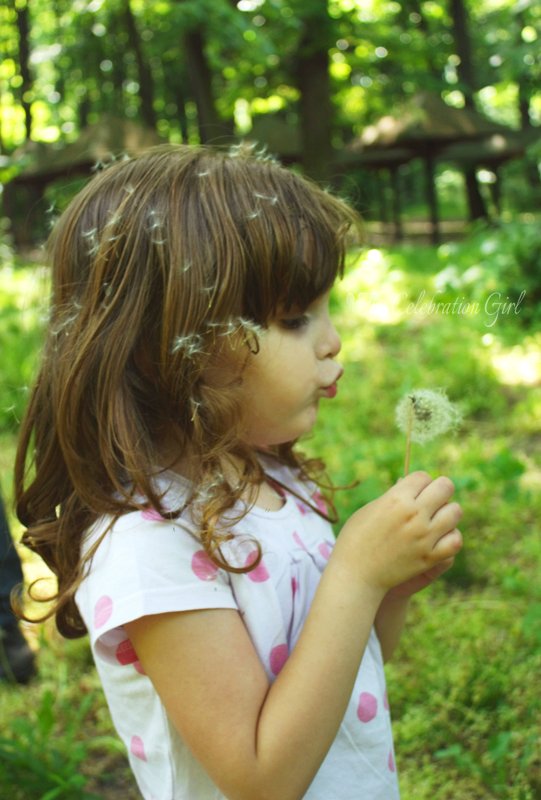
In the almost nine years that my husband and I have been together, we have visited Belgrade together many times. But visiting Belgrade with kids is always a different experience, and one that keeps changing as our children grow.
We arrived to Belgrade on the 30th of April, from Athens, Greece, in a small Fokker plane from Olympus Airlines. Ahead of us was one week of extended holiday because, due to the proximity between the 1st of May and 2013’s Orthodox Easter, most shops and Government agencies were going to remain closed or with limited working hours on the days in between the two holidays. As a consequence, the city (which is normally bustling with excitement and noise) was quite quiet and leisure-like, like a holiday spot
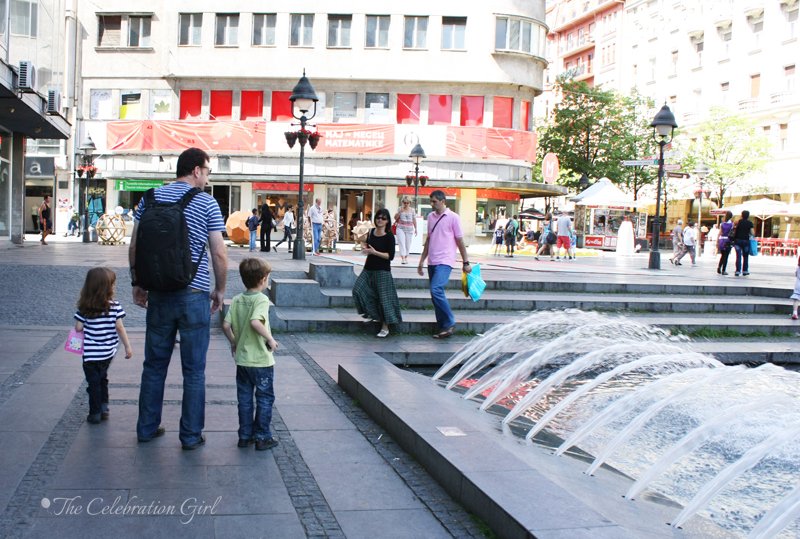
I have mentioned before that, when we travel to Belgrade, we live like locals do, go to the places where locals go and pretty much avoid touristic spots. In this trip, this meant spending the 1st of May having lunch in one of the traditional restaurants that are located in the hills that surround the city.
Going to the hills on Labor Day is an old tradition that marks the beginning of the lovely Spring weather. The tradition, in fairness, is to go for a picnic, and people start arriving and setting up their picnic and camping spots as soon as they wake up, very early in the morning. Soon, the whole place is covered and there are families, and groups of friends chatting, drinking, eating and relaxing, children playing and running all over, musicians, and even salesmen walking around selling ice cream, drinks, and children toys and balloons.
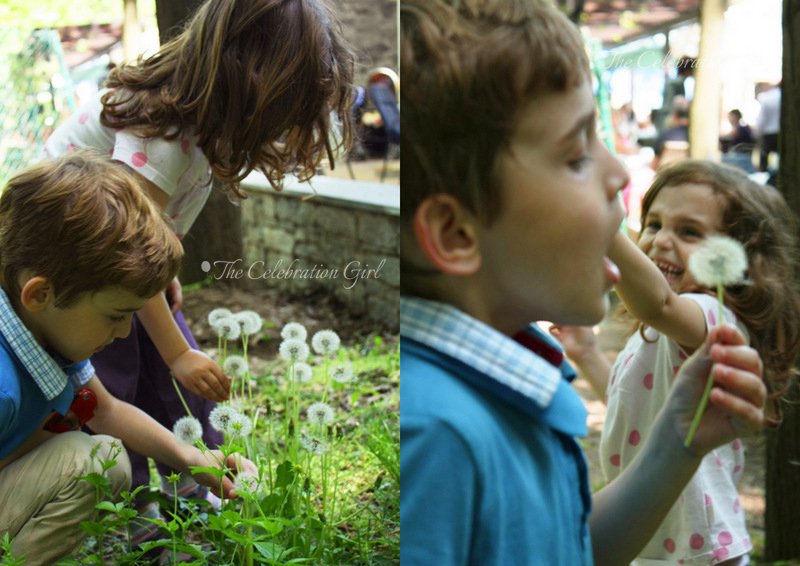
Instead of a picnic, though, this time we opted for a restaurant in the middle of the woods, that had a lovely playground for the children and a piece of land where Luka and Zoe blew dandelions in search of fairies.
When we had finished lunch and were waiting for dessert, something funny happened. A band that was at the restaurant, serenading customers with traditional Serbian music, approached our table and, realizing that I was not speaking Serbian, asked me where I was from. When I mentioned that I was from Argentina, one of them started speaking Spanish to me and they promptly starting playing La muerte del Angel, a tango by Astor Piazzola!
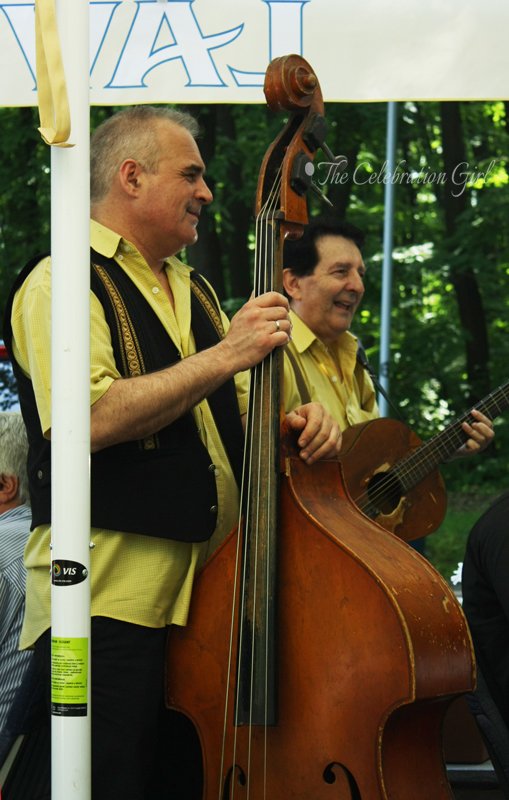
The leisurely feeling of the city influenced the rest of our days in it, as well. We strolled around the streets of downtown, especially the always beautiful Knez Mihajlova, where Luka and Zoe ran, ate ice cream and marveled at the water fountains; and where we could visit the tourist office shop to buy presents to bring back home as well as visit the wonderful math fair that was taking place all month of May.
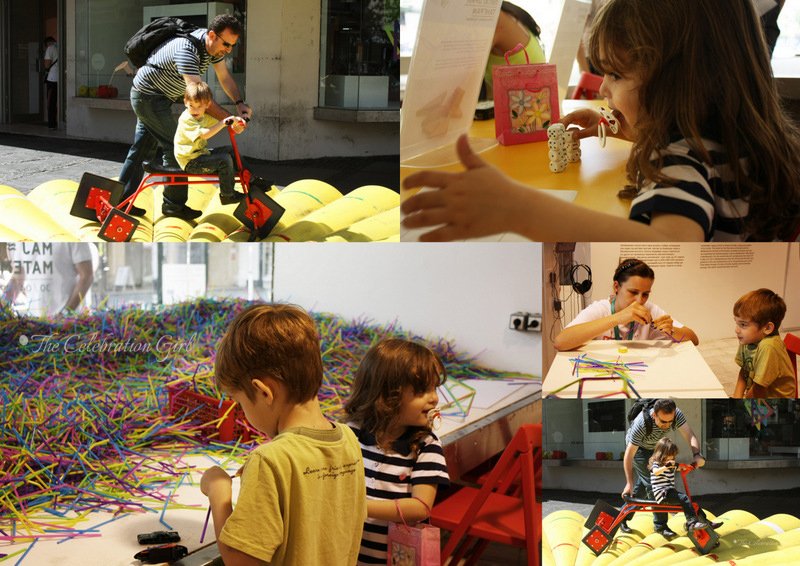
The maths fair, which was full of young volunteers willing to help, was ideal to get children excited about science. There was a bicycle with squared wheels, a floor mat for people to find their way out turning only left (we all tried it and it was hard!), several math games, pendulums, dice experiments, a 3D printer and a fantastic table with thousands of straws that children could put together to create objects, thus bringing awareness to shapes and dimensions.
The squared wheel bicycle, as you can imagine, was a real hit with Luka and Zoe 🙂
We also spent lots of time with family, which is something that, being expats, we don’t get to do often enough.
We took Luka and Zoe to amusement parks, the zoo, and open air playgrounds.
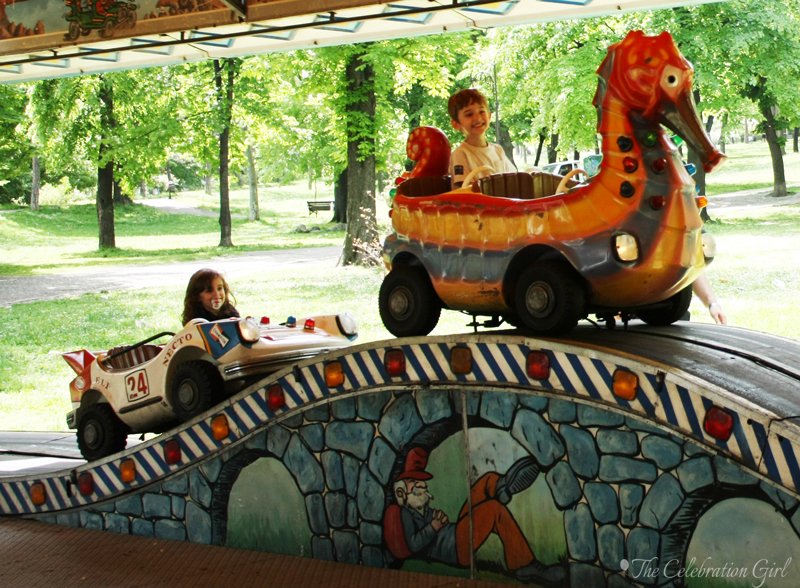
We had cake at my brother in law’s traditional sweet shop, which dates from 1936.
We strolled in the esplanade along the Savva River.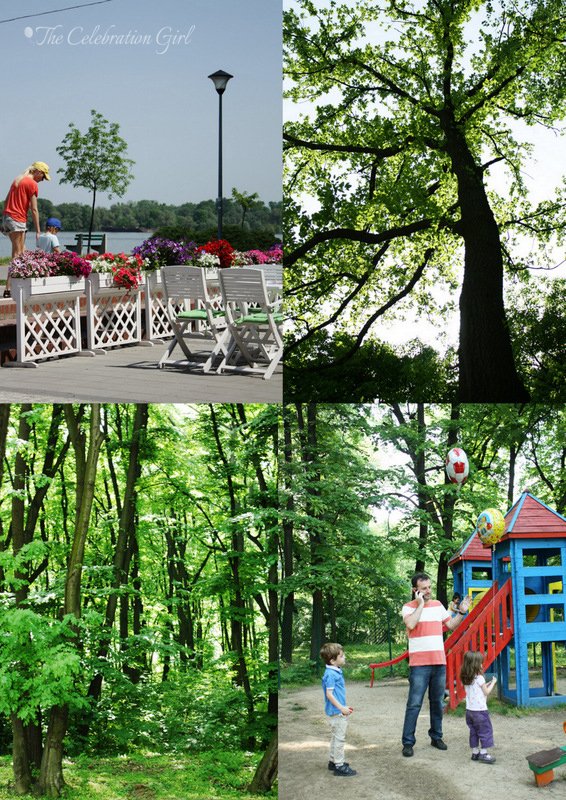
We enjoyed the slow days and the quiet nights.
We relaxed.
Then, 10 days after we arrived, it was time to say goodbye. We took a plane back to Athens, then a plane back to Cyprus and here we are now. At home.
And now, in case you are planning to visit Belgrade with kids (or with adults) I have put together a mini guide of things worth doing, worth seeing and worth eating!
Here it goes:
What to do in Belgrade with Kids
1) Visit Kalemegdan. The old city fortress is a real beauty, not only in itself but also because of the surrounding parks and the view of the Savva and Danube rivers. Lots of space for kids to run, and get excited about history. The fortress also hosts an army museum which kids love.
2) Go to the Zoo: It’s next to Kalemegdan and it’s very well kept. There are elephants, tigers, lions, penguins, seals, hippopotamus, giraffes, zebras, goats, tons of birds and much more.
3) Go to an amusement park: Also, in Kalemegdan. It’s not very big but it’s a nice stop before or after the zoo.
4) Walk around Knez Mihajlova. The most famous street in Belgrade, with its French inspired buildings, is a real beauty.
5) Have lemonade (or Boza) and cake at a traditional Poslaticarnica (or sweet shop). In Belgrade, sweet shops are where traditional cakes and pastries are sold. They are normally rather small and offer a mixture of Northern European cakes (due to the Austro-Hungarian influence) and Oriental delights, such as baklava (due to the times under Ottoman rule). Speaking about Baklava, you will find 3 different types: Greek, Turkish and Serbian (made with nuts mixed with Plazma cookies powder)
6) Try different types of bread at a Pekara (bakery). Cakes and sweets are sold in Poslasticarnicas, and Pekaras are were you can find exclusively bread. Delicious bread!
7) Rent bikes to ride around the Savva river
8) Take a boat ride on the Danube.
9) Have lunch on a “Float” (restaurants on the Savva and Danube)
10) Take a tram ride
11) Buy Plazma cookies at the supermarket. Seriously, you cannot leave without tasting the iconic Serbian cookie with the famous tagline “A house is not a home without Plazma”. And since you are at the supermarket, you may also try Domacica cookies, bananica and cedevita juice. You will look like a local 😉
12) Visit the beautiful Orthodox churches and marvel at their works of art.
13) Buy burek or cevapcice at a local fast food shop and have an improvised picnic in one of the many Belgrade parks.
14) If your kids are bigger than mine, you can go take a look at the buildings bombed by NATO during the war in Kosovo. They were not remodeled nor were they repaired, and it may be a good opportunity to discuss war and recent European history. As a former peacekeeper, I find it important to discuss war and its consequences in times of peace.
15) Taste traditional Serbian food in the beautiful restaurants or Kafana of Skadarlija street (my husband recommends Tri Sesira, Ima Dana or Dva Jelena) For ideas on what to eat, keep reading!
What to eat in a Belgrade Kafana
1) Proja, corn bread (most of the times, it contains a cheese similar to feta inside)
2) Burek: A puff pastry pie, filled with cheese (burek sa sirom) or with meat (burek sa meson). It is possible to find some varieties with Spinach and cheese as well.
3) Corba and other traditional soups. Strictly speaking, corba is soup that contains fish or beef and that is thickened with flour.
4) Sarma: Beef and rice wrapped in vine leaves and cooked for a very long time!
5) Punjene paprike: Red peppers stuffed with rice and beef.
6) Pasulji: Bean stew.
7) Cevapcice: long meat balls made with lamb, pig and beef meat.
8) Tarator: Salad very similar to Tzaziki, made with yogurt, cucumbers, garlic and parsley. Ideal for Summer and for using as a sauce over bread.
9) Ajvar: Red pepper puree.
What to eat in a Poslasticarnica
1) Northern European cakes, such as black forest, or struddel.
2) Triglav: a chocolate buttercream cone, covered in chocolate.
4) Krempita: A bomb. A very thick layer of pastry cream between two slices of puff pastry. Here is a recipe, if you want to try it at home.
5) Baklava: A classic with its own Serbian version,made with plazma cookies and nuts.
6) Kuglof: A wonderful tea cake made with dried fruits.
7) Ratluk: fruit candies,covered in sugar.
Did this post make you want to visit Belgrade? Or at least to eat some Serbian food? If so, mission accomplished 🙂
Have a lovely week, dear friends, and don’t forget to subscribe to get the mini Summer recipes ebook that I created with wonderful Claire Stone!
by Marcela M. | Jun 11, 2013 | Blog, Children, Europe, Travel

Good morning dear friends! I am beginning today the series of posts about our last family trip to Athens and Belgrade, and, since the Summer holidays are almost upon us, I will take this opportunity to share with you all my tips and tricks for travelling with children of different ages.
But first things first, so today I will tell ALL about our one day in Athens with kids!
We had always wanted to visit Athens but, for one reason or another, we had never been able to until last April. I must confess, though, that we had not originally planned to do so in this occasion and that the Universe lent us a hand for making this this micro visit finally happen. You see, whenever we travel to Belgrade, we normally use the Serbian Airline Jat, because they have a 2 1/2 hour direct flight from Larnaca and, up until this year, a schedule that suited us. But in 2013 they started flying in the middle of the night, leaving Cyprus at 2 am in the morning and, while I wouldn’t mind that too much as an adult, we believe that children are a different story. Leaving so late means disturbing our children’s sleep (they are bound to wake up during the several security check ups) and, as a consequence, having to deal with two cranky kids once in Belgrade, and risking a jet lagged sort of change in their normal waking hours, so we started looking for options. And we found them.
Two months before travelling, we booked our tickets to travel through Athens and, since we were already passing by, we decided to make a short stopover in Greece and try to see the Acropolis, at least!. We booked a family room at a nice hotel near Syntagma Square and waited happily for the date of the trip to arrive. We couldn’t wait!
Then, three days before travelling Luka and Zoe got ill with tonsillitis and a ear infection, respectively, and we knew our expectations for the trip had to change.
Travelling with small kids, in general, is very different than travelling alone, with friends, or as a couple. And the key to a happy trip is, in our modest opinion, equal doses of planning and flexibility (and a good deal of patience).
What I mean by equal doses of planning and flexibility is this: We plan the basics carefully: make sure that plane tickets, hotel reservations and documents are up to date and easy to access with one hand. We book hotels that are close to the main attractions of have easy access to them. For stays longer than two nights, we chose to stay in apartments where we can take care of the cooking, w pack with care, making sure that we put extra clothes in our luggage, tons of entertainment, snacks and water (to account for unexpected delays or cancellations), we prepare the children as much as possible by talking about what will happen, where we are going, what we will see.We pack extra money in case there are long delays, research airport websites to know what services are available in the waiting and boarding areas, learn where to get transportation out of the airport fast, how much it should cost to go to our hotel and we save spare cash for this purpose. We even ask our children’s pediatrician for advice on medicines we should bring with us “just in case” (we always carry paracetamol and ibuprofen with us, for example). We are thorough and meticulous in our planning before we leave.
But once we are at the airport/train station/bus station, we know that unexpected things happen all the time and we try to go with the flow.

So,when we found out that Luka and Zoe were ill, we knew that we would need to travel with antibiotics and that they were not going to be feeling at the top of their game. And we knew that this meant quickly lowering our expectations about what we could do in Athens with our kids.
We love travelling and we want our children to learn to love it too. We want them to become globe trotters like ourselves and we believe that the key for this to happen is for us to make sure that the travelling experience is one that is adapted to their developmental age, to what they can do and to what they like. We try to mix activities that we would love to do, with child oriented experiences. We walk a lot but have money ready for a quick taxi in case they are too tired. We know the times of the day when our children are in a better mood and plan more activities during those hours. We mix cultural activities with time in parks and playgrounds where they can relax and spend their abundant energy. And when they are ill, we prioritize making them feel at ease and comfortable and we don’t push for anything at all. During our trip to Athens, this meant not walking much, not climbing to the Acropolis, and seeing the main monuments from the deck of a tourist bus.
And it was the best decision we made.
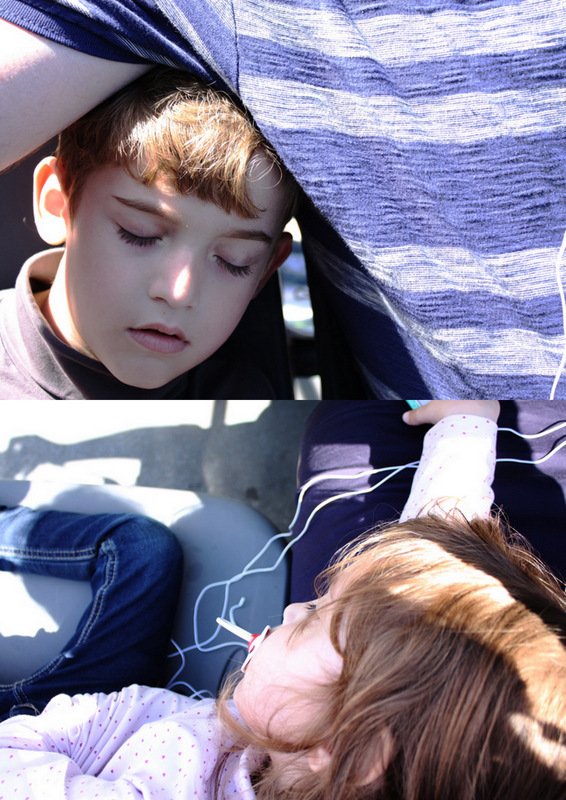
We arrived in Athens on a Sunday, around noon, after a short but nice trip from Larnaca. We went through immigration control pretty fast and found a taxi to take us to our hotel, in a beautiful ride that took us through the hills that surround the ancient city. The streets were quiet, with just a few people strolling quietly, sitting in parks, and many of them meditating and practicing yoga. From the windows of the car, we could spot a few dogs and cats here and there, a few open shops and some groups of tourists like us. But the most surprising thing of all was how at home my husband and I felt there, as if we had lived there before even though it was our first time in the city.
We checked into our hotel, left our luggage in the room and promptly climbed to the restaurant situated on the last floor, from where we knew we would be able to see the Acropolis.
It was stunning.
We had a few drinks, our jaws dropped at its beauty, and then went down to the hotel’s reception to see how far it was and how easily accessible it was to evaluate the feasibility of going with our children.
It turned out that it was pretty close by, and that the path to get there was a beautiful one, full of little shops and cafés, so we decided to give it a try. It was almost lunch time already by the time we left the hotel, so we figured that, if Luka and Zoe got too tired on the way there, we could always stop at one of the cute little restaurants, grab a bite and then continue. Or, if they were not feeling well by the time we finished lunch, we could always go back to the hotel and let them rest watching cartoons, or take a nap. In the end, this is what we ended up doing.
After they had taken a nap, we started looking for things to do, for a way to take at least a brief look at the city, but that wouldn’t push Luka and Zoe beyond their point of comfort. We wanted them to enjoy the sightseeing, not to struggle!
We were brainstorming ideas in our room, when I remembered seeing the double-deck tourist buses around Syntagma square. I went down to the reception and found a brochure with all stops, packed snacks and water for the children, and we left.
The bus stop was barely 200 meters from our hotel and, by the time we arrived, there was a bus there already. Luka and Zoe were very excited about travelling on the upper side, getting their headphones in their ears and being able to touch the tallest branches of the trees and the streets from above.
A few minutes after the bus began moving, however, the fell soundly asleep again!
The afternoon was sunny, and there was a lovely breeze that prevented the weather from getting too hot. The city felt quiet and relaxed, and it was really nice to be able to, at least, get a glimpse of it.
During the 90 minutes that the itinerary lasted, we saw Melina Merkouri, Plaka, the New Acropolis Museum, the Acropolis and Parthenon, the Temple of Zeus, the National Gardens, the Benaki Museum, Panathenaic Stadium, the National Library), the National Archaeological Museum, Omonoia Square, Karaiskaki Square, Thession Station, and Kotzia Square. We took pictures trying to avoid the heads of other passengers (a difficult task!), we chatted and we planned future trips.
By the time the bus tour was finished, we had already fell in love with the city, and decided to go back one day, to walk and walk and walk.
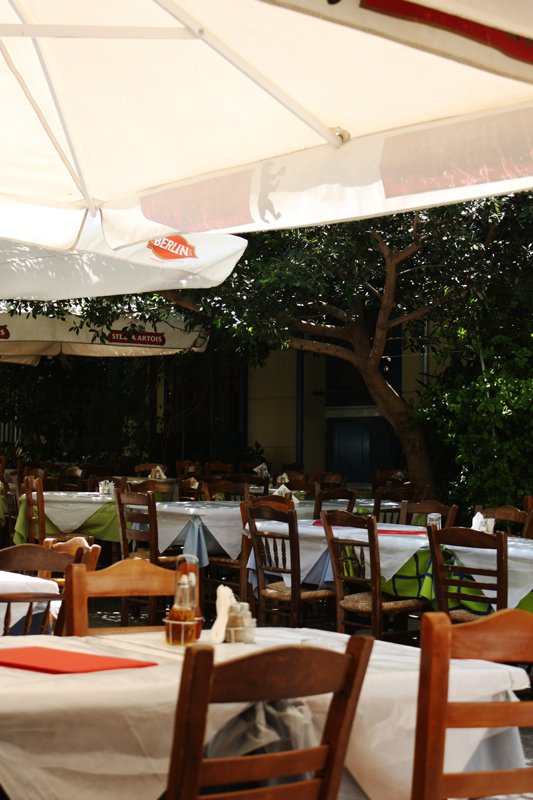
We took off the bus, treated Luka, Zoe and ourselves to a few scoops of delicious ice cream and went back to the hotel, where we later had dinner, watching the sun set over the city.
Early the following morning, we took our flight to Belgrade…but I’ll tell you about it in my next post!
Have you ever been to Athens? Would you like to?

by Marcela M. | Apr 30, 2013 | Blog, Children
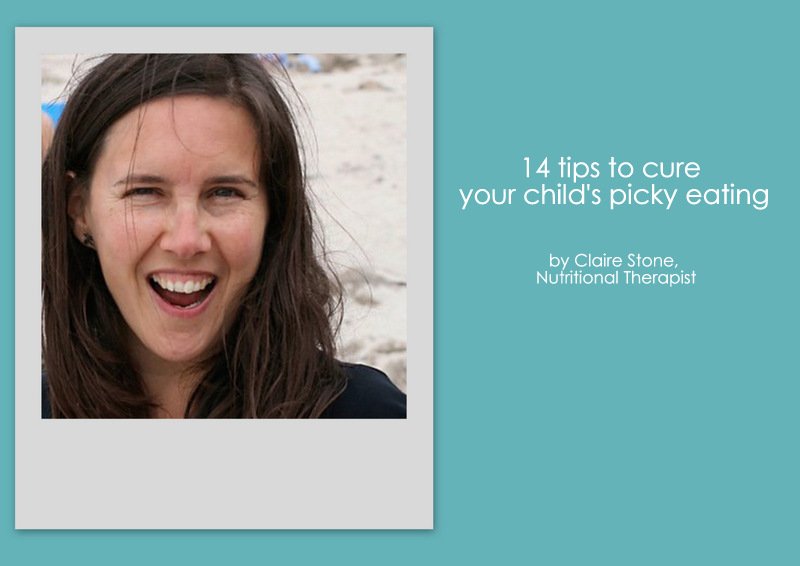
Good morning dear friends!
As promised, here is the second post about ways to cure picky eating habits, with the 14 tips list itself. I hope it will hlp you design a strategy that is right for your family, and to end mealtime struggles.
Here are Claire’s tips:
14 tips to cure your child’s picky eating
1) The very first one is DON’T PANIC. Quite often, fussiness is more about control than it is about the food in question. If you get stressed, your kids will know, and they’ll push that stress button of yours as much as they can. Unless there is a specific and urgent health matter going on, trust that your kids will be ok.
2) If your child is not eating at all, check what else may be going on (see Part I of this post here for more details).
3) Establish a mealtime routine. Kids need regularity.
4) If your mealtimes have turned into a battle ground, see if your children can have a meal with someone else to see whether they eat or not.
5) Offer something fresh at every meal: fruits, veggies, nuts or seeds.
6) Make it a vague rule that people do have to try foods. I say ‘vague’ because just making it a rule won’t work. Instead, when your kids say they’ve finished, and want their pudding now, just sweetly remind them to try the green beans/sauce or whatever. They’ll fight it, but if they know that pudding is waiting on them just sticking one tiny piece of greenery in their mouths, they may well be up for it.
7) If your kids nag you for food when they come home from school, happily give in by only offering them a raw piece of the veg that they will be having later. So, if you are chopping cabbage, just give them a piece of cabbage. If you make it clear that the only snack is the same as what they’ll be eating later, they’ll either take it, or quit asking. It might take a few days to get it to sink in, but once it does, you’ll be happy regardless of whether they eat the raw veg or just leave you alone
8) The Spring is a great time to really move picky eaters forward. Our bodies naturally want to eat less fatty, sugary foods in the Spring, mainly because we don’t need to be storing up energy to survive the Winter. Our bodies naturally crave the magnesium in green veg and it craves the freshness of fresh foods. If there was one time of year when the odds are in your favour for getting your children to prefer healthy foods, it is NOW!
To take full advantage of the Spring, you could try growing your own foods such as sprouted green lentils, cress and salad leaves all grow super fast. Kids are so much more likely to try foods which they helped to grow. But remember, you have to take part too – if you sit there thinking that this is all rabbit foods, please don’t be surprised if your kids think the same. You may well enjoy the sunshine that seems to burst from fresh foods yourself
9)Foods that are great for the Spring are all the ones which are appearing where you live – fresh leafy things, fruits and veg that are coming up now are perfect. And they taste better. A fresh orange picked from your tree tastes sooo much better than an orange flown in from half-way around the world. Go fruit picking perhaps, or visit a farm so that you have a good idea of what is in season, but also so that your child can develop an independent idea about food without your direct input.
10) Make your own salad dressing. Seriously. My kids will eat any kind of salad, because they have been trained by my nifty take on a salad dressing to love it. I take olive oil, balsamic vinegar and a dash of honey to sweeten it up a tad and splash it on a salad. Now, even if there is no dressing, my kids will happily eat plenty of salad.
11) Don’t confuse your children. They will watch and learn from you. If you only eat salad when you are on diet, or you make jokes about eating grass when you serve up broccoli, your kids will know that your heart isn’t in it, and they’ll feel just the same. If you at least try something new, or make an effort to have a mouthful or two of something that you don’t really like, they’ll see it, do their best to ignore it, but at least the precedent has been set. You can then say ‘I don’t like peas either, but I always try a few just in case these are the ones that I will like’. (or something similar).
12) Get Dr Seuss book ‘Green Eggs and Ham’- it has been a brilliant addition to our family because it’s all about trying new foods and really does inspire kids. And give massive praise at mealtimes for trying something, and don’t worry if they don’t like it.
13) One of my biggest bug-bears and one which we all do (myself included occasionally) is when a child says ‘I don’t like that’ and we say ‘Yes you do’. It totally negates the little bit of power that the child is trying to put out there. Instead of telling them that they do like it, try just saying ‘Ok. Well, I’ve given you a little bit so you can see how you feel today’ and leave it at that. Remember, it’s all about the power – let them have a little bit of power when they want it, and they won’t then be fighting with you in every other way.
14)Hiding veggies and fruit is absolutely a brilliant way to get kids to eat food. But I am not really one for being sneaky. My reason for suggesting this is that it helps to slowly, without stress, train their taste buds. For example: my daughter HATES courgette. With a passion. But, I’ll make a pasta sauce, with some grated courgette in it. She eats it, perfectly happily. So, her taste buds get to experience the courgette and realize that it isn’t something strange. She gets the lovely goodies in courgette without having to feel she is being forced to eat something she doesn’t like. And I get to know that it’s not the TASTE of courgettes that she doesn’t like, it’s the texture. If that sounds a bit crazy, hear this: I only like courgette if it is finely cut up. Big bits of courgette turn my stomach. Why? I have no idea, but I can totally relate to her story. Eating isn’t just about the taste, it’s about the texture, the look, the smell of foods. Children can’t explain this – they just either ‘like’ it or they ‘don’t like’ it. Hiding foods, or changing the texture is a great way to explore foods without the stress of actually ‘trying’ something. Be careful though – if you hide a vegetable in foods, and your child then hates the food even though they aren’t aware that there is something in the food, there is the slight chance the food doesn’t suit them which is making them dislike it. So, as an example, they may be slightly intolerant to it, perhaps.Finally, be mindful and gentle with yourself: it is hard and you are not alone in this battle. Sometimes you have to step back and trust in your child. Give them the right tools, and you might well be surprised by what they will eat. Try not to do what we all do, which is worry that they haven’t eaten enough and give a sugary pudding or treat when they refuse their food so that they ‘have at least eaten something’. Kids are fast learners, and if you do want them to try new foods, you just have to go with the flow and trust they’ll eat enough if the good stuff is there.
So, there you have it. I don’t have all the answers because each and every child is different, and each and every parent is different. It would take me hours to give all the possible solutions that I know, and even they might not be enough. But take a look through the list above, and see if one or two or three of my suggestions sound like something that would work for you.If you are really struggling, I’d love to help you. Drop me an email, and outline your problem, and I’ll get back to you with a couple of suggestions crafted just for you. They might or might not work (who can tell), but sometimes you just need an outside eye on a problem that is close to your heart.Sign up to my website – and get a short (but sweet) list of some of my favourite nutrition books. There are two books all about children and food in that list, both of which not only got me through the weaning and toddler years, but are still useful to me now, both as a nutritionist, and as the mum of two girls who know exactly what they like to eat and precisely what they don’t! Ahh, that’s got me thinking – I can’t remember who likes cooked carrots again this week.
Isn’t Claire wonderful? I love her tips because they are easy to put in practice, all we need is little courage to get started and to brace ourselves for the initial resistance we may encounter.
Did you like the tips? Which are the ones you are most likely to put in practice soon/that you think will work better for your children? Please, share in the comments below!
Con sabor latino…
Buenos dias queridos amigos! Tal como lo prometi, aqui esta la segunda parte del post acerca de como curar las mañas alimenticias de nuestros niños. Espero de todo corazón que los ayuden a diseñar una estrategia adaptada a sus familias, que acabe con las batallas a la hora de la comida!
Ahora los dejo con Claire:
14 tips para curar las mañas alimenticias
1) El primero de todos es que NO ENTRES EN PANICO SI TU HIJO ES MAÑOSO. Muy frecuentemente la mañosidad es más una cuestión de control que de gustos alimenticios. Si tu te estresas, tus hijos lo notarán, y jugarán con eso de muchas maneras. Salvo que haya un problema de salud específico, confiá en que tus hijos estarán bien.
2) Si tu hijo no come nada de nada, fijate qué mas puede estar ocurriendo (recuerda revisar los puntos que Claire mencionó en el post anterior)
3) Establece horarios y rutinas de comida. Los niños necesitan regularidad.
4) Si las comidas se han tornado en un verdadero campo de batalla, fíjate si tu hijo puede comer con alguien que no seas tu para ver si así comen o no, y qué comen.
5) Ofrece algo fresco en cada comida: fruta, verdura, nueces o semillas.
6) Incluye vagamente como regla de la casa la idea de que todos tienen que probar la comida. No seas muy rigido, porque el solo establecerla como regla no va a funcionar. En lugar de esto, cuando tus hijos declaren que han terminado de comer y pidan el postre, recuerdales dulcemente que deben probar aquello que no han tocado. Se van a oponer, sin dudas, pero saber que tienen la promesa del postre esperándoles los hará mas proclives a ponerse un pequeño trozo de lechuga en la boca.
7) Si tus hijos te acosan por comida cuando llegan de la escuela, dales un trozo del mismo vegetal crudo que piensas darles en la comida. Por ejemplo, si estas cortando repollo, dales un trozo del mismo. Si les dejas bien en claro que el unico snack que obtendran será ese, puede que lo tomen o lo dejen pero en cualquier caso aprenderán la regla rápidamente y tu estaras contenta de saber que comen verduras crudas o bien de que te dejen cocinar en paz.
8) La primavera es la estación ideal para introducir nuevos y buenos hábitos alimenticios. Nuestros cuerpos están programados naturalmente para querer alimentos reducidos en calorías y sin tanta azucar, fundamentalmente porque no necesitamos guardar energia para el invierno. Nuestros cuerpos desean naturalmente el magnesio de las verduras verdes, y la frescura de los alimentos crudos. O sea que si hubiera una época del año ideal para que tus hijos prefieran comidas saludables sería justamente ESTA.
Para aprovecharla lo más posible, es una buena idea, plantar tus propias verduras, como hojas de lechuga, y brotes de lentejas verdes, que crecen super rapido. Los niños son más proclives a probar alimentos que han visto crecer. Sólo recuerda que tu tambien tienes que participar en el proceso, si tu solo te sientas al lado pensando “esta es comida de conejos” no te sorprendas si tus hijos piensan los mismo!. Disfuta del sol y del proceso junto a ellos.
9) Los mejores alimentos son los de estación, o sea aquellos que están apareciendo en las góndolas de los supermercados en este momento. Y saben mejor. Una naranja recogida de tu propio arbol sabe mucho mejor que una que ha viajado del otro lado del mundo. Por eso otra buena idea es ir a recolectar frutas junto con tu hijo, si tienes quintas cercanas, llevalos a una granja donde tus hijos puedan ver cuales son las frutas de estación y pueda desarrollar sus propias ideas acerca de la comida.
10) Haz tus propios aliños para las ensaladas. Yo hago el mio con aceite de oliva, acetto balsamico y u poquito de miel para darle dulzura y mis hijos devoran las ensaladas gracias a eso.
11) No confundas a tus hijos. Si ellos ven que tu sólo comes ensaladas cuando estas a dieta y haces bromas acerca de comer pasto cuando sirves brócoli, tus hijos sabrán que no te gusta y tampoco les gustarán esos alimentos. Si al menos pruebas y haces el esfuerzo ellos lo notarán,intentarán ignorarlo pero al menos sentarás un buen precedent. Incluso puedes decirles “A mi tampoco me gustan las arvejas, pero siempre pruebo algunas a ver si esas sí me gustan” (o algo similar)
12) Consigue el libro de Dr. Seuss “Huevos verdes y jamón”, que ha sido una adición brillante a nuestra biblioteca porque trata justamente acerca de probar nuevas comidas y es super inspirador para los niños. Pero no te detengas allí: alaba muchísimo a tus niños, haz una fiesta cada vez que prueban algo nuevo sin preocuparte si no les gusta.
13) Uno de los mayores problemas es cuando el niño dice “no me gusta esto” y los padres respondemos “si te gusta”porque niega su individualidad y el pequeño rescoldo de poder que el niño pretende tener en esa situación. En lugar de eso, diles que está bien, que por eso justamente haz puesto solo un poquito en su plato para que el pueda ver cómo se siente al respecto en el dia de la fecha”. Y dejalo ahí. Recuerda que estas son peleas por poder, dejales que tengan un poquito de poder en pequeñas batallas para que no peleen por absolutamente todo.
14) Esconder frutas y verduras es una manera fantastica de hacer que los chicos prueben distintos sabores. Yo no soy muy escondedora, pero sí suelo sugerirlo porque ayuda a desestresar la situacion y tambien ayuda a acostumbrar las papilas gustativas a los distintos sabores. Por ejemplo, mi hija odio con pasión los zapallitos, pero si los incluyo en salsa de pasta, rallada, lo come feliz de la vida. Eso me permite saber que no es el sabor del zapallito lo que no le gusta, sino su textura. En el acto de comer estan en juego muchos de nuestros sentidos, no es solo el gusto lo que está en juego sino tambien la textua, el olor y el aspecto de la comida. Los niños no pueden explicar esto, para ellos es sólo algo que les gusta o no. Esconder alimentos o cambiar su textura es una buena manera de hacerlos probar nuevos alimentos sin el stress que implica para ellos hacerlo. Ten en cuenta, sin embargo, que si escondes verduras en algun alimento y tu hijo se niega a probarlo, puede que esto se deba, por ejemplo, a que tengan una intolerancia al mismo.
Finalmente, se amable y gentil contigo mismo, esta es una batalla dificil pero no estas solo. A veces deberás dar un paso atrás y confiar en tu niño. Ocupate de armarlos con las insrumentos adecuados para tomar sus propias decisiones y puede que ellos te sorprendan. Eso sí, intenta no hacer lo que todos hacemos, que es preocuparte de que no han comido suficiente y darles un postre para que “al menos coman algo”. Los niños aprenden rápido y si de verdad quieres que prueben nuevos alimentos debes dejarte llevar y confiar en que comeran suficiente si sólo tienen delante alimentos saludables.
Allí los tienen, esos son mis tips. No tengo todas las respuestas porque cada niño es diferente y cada familia es diferente. Me llevaría horas poder compartir con ustedes todas las soluciones a cada problema especifico y aun así eso podría no llegar a ser suficiente. Lean la lista que les he dejado, y fíjense si una o dos de mis sugerencias pueden adaptarse a su familia. Si de verdad tienen muchos problemas con este tema, me encantaria poder ayudarlos. Pueden enviarme un email detallandome el conflicto especifico y yo les respondere con un par de ideas que pueden funcionar. A veces lo que necesitamos es una mirada objetiva, no? Tambien pueden subscribirse a mi página web y recibiran una lista de mis libros de nutrición favoritos, que incluye dos específicamente adaptados a los niños.
——————-
¿Qué les ha parecido este post? ¿No es Claire maravillosa? Sus tips me encantan porque son sensatos, adaptables y fáciles de poner en practica ¿verdad?
Y a ustedes ¿les han gustado estos tips? ¿Cuales les paracen más adaptables a su hogar? Cuentenme en los comentarios!



















